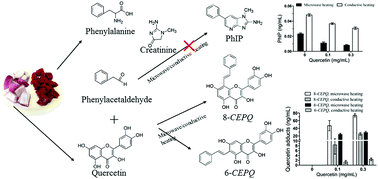当前位置:
X-MOL 学术
›
Food Funct.
›
论文详情
Our official English website, www.x-mol.net, welcomes your feedback! (Note: you will need to create a separate account there.)
A comparison of mutagenic PhIP and beneficial 8-C-(E-phenylethenyl)quercetin and 6-C-(E-phenylethenyl)quercetin formation under microwave and conventional heating
Food & Function ( IF 6.1 ) Pub Date : 2018-06-21 00:00:00 , DOI: 10.1039/c8fo00542g Daming Fan 1, 2, 3, 4, 5 , Lijie Li 1, 2, 3, 4, 6 , Nana Zhang 1, 2, 3, 4, 6 , Yueliang Zhao 4, 5, 7, 8, 9 , Ka-Wing Cheng 4, 5, 7, 8 , Bowen Yan 1, 2, 3, 4, 6 , Qian Wang 1, 2, 3, 4, 6 , Jianxin Zhao 1, 2, 3, 4, 6 , Mingfu Wang 4, 5, 7, 8 , Hao Zhang 1, 2, 3, 4, 6
Food & Function ( IF 6.1 ) Pub Date : 2018-06-21 00:00:00 , DOI: 10.1039/c8fo00542g Daming Fan 1, 2, 3, 4, 5 , Lijie Li 1, 2, 3, 4, 6 , Nana Zhang 1, 2, 3, 4, 6 , Yueliang Zhao 4, 5, 7, 8, 9 , Ka-Wing Cheng 4, 5, 7, 8 , Bowen Yan 1, 2, 3, 4, 6 , Qian Wang 1, 2, 3, 4, 6 , Jianxin Zhao 1, 2, 3, 4, 6 , Mingfu Wang 4, 5, 7, 8 , Hao Zhang 1, 2, 3, 4, 6
Affiliation

|
2-Amino-1-methyl-6-phenylimidazo[4,5-b]pyridine (PhIP) is the most abundant mutagen/carcinogen produced in high temperature treated protein food. Quercetin has been shown to inhibit PhIP formation by trapping phenylacetaldehyde to form two human beneficial adducts 6-C-(E-phenylethenyl)quercetin (6-CEPQ) and 8-C-(E-phenylethenyl)quercetin (8-CEPQ). Here we studied the formation of PhIP as well as the phenylacetaldehyde-trapping ability of quercetin in microwave heating and conventional heating systems. LC-MS was applied for the comparison of PhIP formed in chemical models using microwave heating and conductive heating. Results showed that PhIP was produced time dependently under both heating conditions. Microwave heating produced a smaller amount of PhIP compared with conductive heating. Moreover, quercetin showed a more potent inhibitory effect on PhIP formation in microwave heating systems than in conductive heating models. The amount of 6-CEPQ and 8-CEPQ produced in chemical models and onion/beef soup using microwave heating was about 5 and 1.5 times more than using conductive heating, respectively. Our results demonstrate that microwave heating was a much safer and healthier thermal processing technology than conventional heating in terms of formation of less mutagenic PhIP and production of more human beneficial compounds 6-CEPQ and 8-CEPQ.
中文翻译:

微波和常规加热下 诱变PhIP和有益的8- C-(E-苯基乙烯基)槲皮素和6- C-(E-苯基乙烯基)槲皮素的比较
2-氨基-1-甲基-6-苯基咪唑并[4,5- b ]吡啶(PhIP)是高温处理的蛋白质食品中产生的最丰富的诱变剂/致癌物。槲皮素已显示出通过捕获苯乙醛形成两种人类有益的加合物6- C-(E-苯基乙烯基)槲皮素(6- CEPQ)和8- C-(E-苯基乙烯基)槲皮素(8- CEPQ)来抑制PhIP的形成)。在这里,我们研究了微波加热和常规加热系统中PhIP的形成以及槲皮素的苯乙醛捕获能力。LC-MS用于比较使用微波加热和传导加热在化学模型中形成的PhIP。结果表明,在两种加热条件下,PhIP的产生时间均与时间有关。与传导加热相比,微波加热产生的PhIP量更少。而且,槲皮素对微波加热系统中的PhIP形成显示出比传导加热模型更有效的抑制作用。6- CEPQ和8- CEPQ的数量在化学模型和洋葱/牛肉汤中使用微波加热生产的产品分别比使用传导加热生产的产品大约高5倍和1.5倍。我们的结果表明,就形成较少的致突变性PhIP和生产更多对人体有益的化合物6- CEPQ和8- CEPQ而言,微波加热是一种比传统加热更为安全和健康的热处理技术。
更新日期:2018-06-21
中文翻译:

微波和常规加热下 诱变PhIP和有益的8- C-(E-苯基乙烯基)槲皮素和6- C-(E-苯基乙烯基)槲皮素的比较
2-氨基-1-甲基-6-苯基咪唑并[4,5- b ]吡啶(PhIP)是高温处理的蛋白质食品中产生的最丰富的诱变剂/致癌物。槲皮素已显示出通过捕获苯乙醛形成两种人类有益的加合物6- C-(E-苯基乙烯基)槲皮素(6- CEPQ)和8- C-(E-苯基乙烯基)槲皮素(8- CEPQ)来抑制PhIP的形成)。在这里,我们研究了微波加热和常规加热系统中PhIP的形成以及槲皮素的苯乙醛捕获能力。LC-MS用于比较使用微波加热和传导加热在化学模型中形成的PhIP。结果表明,在两种加热条件下,PhIP的产生时间均与时间有关。与传导加热相比,微波加热产生的PhIP量更少。而且,槲皮素对微波加热系统中的PhIP形成显示出比传导加热模型更有效的抑制作用。6- CEPQ和8- CEPQ的数量在化学模型和洋葱/牛肉汤中使用微波加热生产的产品分别比使用传导加热生产的产品大约高5倍和1.5倍。我们的结果表明,就形成较少的致突变性PhIP和生产更多对人体有益的化合物6- CEPQ和8- CEPQ而言,微波加热是一种比传统加热更为安全和健康的热处理技术。



























 京公网安备 11010802027423号
京公网安备 11010802027423号